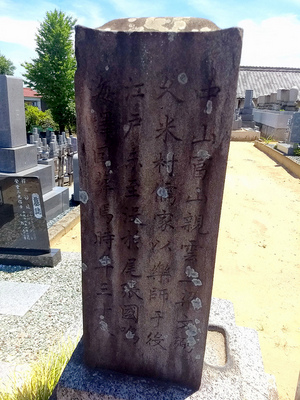Difference between revisions of "Ryo Bunhitsu"
(Created page with "*''Born: 1794'' *''Died: 1832/11/3'' *''Titles'': 富山親雲上 ''(Tomiyama peechin)'' *''Japanese'': 梁文弼 ''(Ryou Bunhitsu)'' Ryô Bunhitsu, also known by his...") |
|||
| (4 intermediate revisions by the same user not shown) | |||
| Line 1: | Line 1: | ||
| + | [[File:RyoBunhitsu.jpg|right|thumb|400px|Gravestone for Ryô Bunhitsu at [[Zuisen-ji (Nagoya)|Zuisen-ji]] in [[Nagoya]]]] | ||
*''Born: [[1794]]'' | *''Born: [[1794]]'' | ||
*''Died: [[1832]]/11/3'' | *''Died: [[1832]]/11/3'' | ||
*''Titles'': 富山親雲上 ''(Tomiyama peechin)'' | *''Titles'': 富山親雲上 ''(Tomiyama peechin)'' | ||
| − | *''Japanese'': | + | *''Japanese'': [[梁]]文弼 ''(Ryou Bunhitsu)'' |
Ryô Bunhitsu, also known by his title, Tomiyama ''[[peechin]]'', was a Ryukyuan scholar-aristocrat who served as a musician on the [[1832]] [[Ryukyuan embassy to Edo]]. | Ryô Bunhitsu, also known by his title, Tomiyama ''[[peechin]]'', was a Ryukyuan scholar-aristocrat who served as a musician on the [[1832]] [[Ryukyuan embassy to Edo]]. | ||
| − | He died on the way to [[Edo]], at [[Inaba-juku]] in [[Owari province]], on 1832/11/3, and was buried the following day at [[Zuisen-ji (Nagoya)|Zuisen-ji]], a temple at [[Narumi-juku]] on the [[Tokaido|Tôkaidô]]. He was one of a number of Ryukyuan officials to die while on such missions in Japan, as the result of what was called ''Ryûkyû no kaze'' (the Ryukyuan cold); it is unclear precisely what sort of ailment this was, but it is believed that as Ryukyuans were not used to the colder weather of Japan, they were more susceptible to "catching a cold" (or worse) and falling ill. | + | He died on the way to [[Edo]], at [[Inaba-juku]] in [[Owari province]], on 1832/11/3, and was buried the following day at [[Zuisen-ji (Nagoya)|Zuisen-ji]], a temple at [[Narumi-juku]] on the [[Tokaido|Tôkaidô]]. He was one of a number of Ryukyuan officials to die while on such missions in Japan, as the result of what was called ''Ryûkyû no kaze'' (the Ryukyuan cold); it is unclear precisely what sort of ailment this was, but it is believed that as Ryukyuans were not used to the colder weather of Japan, they were more susceptible to "catching a cold" (or worse) and falling ill. He was staying along with Vice Envoy Takushi ''peechin'' and 19 others at a shogunate-associated lodging in Inaba when he died; there is no evidence in the documents of Bunhitsu being ill for any length of time, so it appears he may have died fairly suddenly.<ref>Miyagi Eishô 宮城栄昌, ''Ryûkyû shisha no Edo nobori'' 琉球使者の江戸上り, Tokyo: Daiichi Shobô (1982), 212.</ref> |
Two pairs of hanging scrolls featuring Bunhitsu's calligraphy are today held at Zuisen-ji. It is believed that they were brought from Ryûkyû by the [[1842]] and [[1850]] missions to [[Edo]], when they passed through Narumi and paid visits to Bunhitsu's grave. One reads, in large characters, 「海清」and「龍飛」 ("pure/clear sea" and "dragon flying"), while the other pair features lengthier poetry, reading 「小梅香裏黄鶯囀 玉樹隠中紫鳳来」and 「白雲深處無塵事 好鳥聞時尽妙音」. Both are signed ''[[Chuzan|Chûzan]] Ryô Bunhitsu''. | Two pairs of hanging scrolls featuring Bunhitsu's calligraphy are today held at Zuisen-ji. It is believed that they were brought from Ryûkyû by the [[1842]] and [[1850]] missions to [[Edo]], when they passed through Narumi and paid visits to Bunhitsu's grave. One reads, in large characters, 「海清」and「龍飛」 ("pure/clear sea" and "dragon flying"), while the other pair features lengthier poetry, reading 「小梅香裏黄鶯囀 玉樹隠中紫鳳来」and 「白雲深處無塵事 好鳥聞時尽妙音」. Both are signed ''[[Chuzan|Chûzan]] Ryô Bunhitsu''. | ||
| Line 12: | Line 13: | ||
==References== | ==References== | ||
*''Minoji wo yuku Ryûkyû shisetsu'' 美濃路をゆく琉球使節, Bisai Museum of History and Folklore 尾西市歴史民俗資料館, Bisai, Aichi (2004), 12. | *''Minoji wo yuku Ryûkyû shisetsu'' 美濃路をゆく琉球使節, Bisai Museum of History and Folklore 尾西市歴史民俗資料館, Bisai, Aichi (2004), 12. | ||
| + | <references/> | ||
[[Category:Ryukyu]] | [[Category:Ryukyu]] | ||
Latest revision as of 03:13, 18 December 2018
Ryô Bunhitsu, also known by his title, Tomiyama peechin, was a Ryukyuan scholar-aristocrat who served as a musician on the 1832 Ryukyuan embassy to Edo.
He died on the way to Edo, at Inaba-juku in Owari province, on 1832/11/3, and was buried the following day at Zuisen-ji, a temple at Narumi-juku on the Tôkaidô. He was one of a number of Ryukyuan officials to die while on such missions in Japan, as the result of what was called Ryûkyû no kaze (the Ryukyuan cold); it is unclear precisely what sort of ailment this was, but it is believed that as Ryukyuans were not used to the colder weather of Japan, they were more susceptible to "catching a cold" (or worse) and falling ill. He was staying along with Vice Envoy Takushi peechin and 19 others at a shogunate-associated lodging in Inaba when he died; there is no evidence in the documents of Bunhitsu being ill for any length of time, so it appears he may have died fairly suddenly.[1]
Two pairs of hanging scrolls featuring Bunhitsu's calligraphy are today held at Zuisen-ji. It is believed that they were brought from Ryûkyû by the 1842 and 1850 missions to Edo, when they passed through Narumi and paid visits to Bunhitsu's grave. One reads, in large characters, 「海清」and「龍飛」 ("pure/clear sea" and "dragon flying"), while the other pair features lengthier poetry, reading 「小梅香裏黄鶯囀 玉樹隠中紫鳳来」and 「白雲深處無塵事 好鳥聞時尽妙音」. Both are signed Chûzan Ryô Bunhitsu.
References
- Minoji wo yuku Ryûkyû shisetsu 美濃路をゆく琉球使節, Bisai Museum of History and Folklore 尾西市歴史民俗資料館, Bisai, Aichi (2004), 12.
- ↑ Miyagi Eishô 宮城栄昌, Ryûkyû shisha no Edo nobori 琉球使者の江戸上り, Tokyo: Daiichi Shobô (1982), 212.
